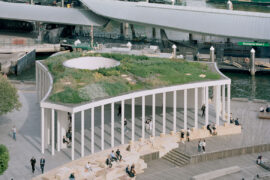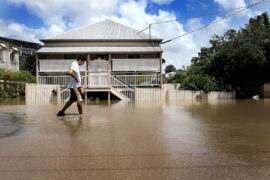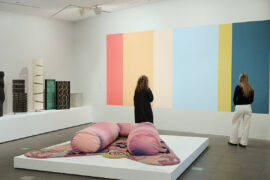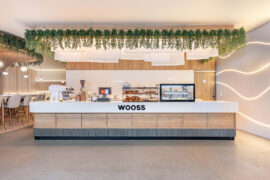Heide Museum of Modern Art and Urban Initiatives have worked closely with the Wurundjeri community to rebuild Heide’s connection to Country. Gillian Serisier relates a story of reconnections – both new and old.

Photography by Daniel Walker.
January 10th, 2023
This piece was originally published in Indesign #87: The ‘State of Wellbeing’ Issue.
Occupying a site of some 10,000 square metres, Yaluk Langa (River’s Edge) hugs the banks of the Birrarung, or Yarra River, forming the north-western border of the Heide Museum of Modern Art (Heide) grounds. Landscape architecture practice, Urban Initiatives, was tasked by Heide to consider this area in light of key objectives in keeping with museum founder John Reed’s 1960s directive to “preserve and perhaps rehabilitate as much as possible of the Valley”.
The Heide property was purchased by the Reeds in 1934, who set about planting the largely denuded site with trees and European-style gardens. The same year, a record-breaking flood deposited masses of Indigenous seed at the river’s edge, which continued to germinate in subsequent decades. In the 1960s, Reed was struck by the magnificence of a bright red Callistemon that had self-sown by the river. He began researching and planting Indigenous species and, in 2018, the Albert and Barbara Tucker Foundation provided Heide with the means to continue Reed’s work.
Urban Initiatives was engaged in 2019 to document the revegetation of a portion of the site. In this initial capacity, site response sketches, an arborist report and site timeline were created. However, Katherine Rekaris, senior landscape architect at Urban Initiatives, felt a more meaningful shift had to take place: “We have the Heide site with its straight boundaries, but the land sits on Wurundjeri Country. As well intentioned as the idea of landscape restoration might be, real restoration to the ‘pre-Colonial landscape’, which was in truth highly managed, is simply not possible without Traditional Owner collaboration”.

As such, Rekaris instigated a comprehensive and considered approach that brought the Wurundjeri people into the consultation process to create the Yaluk Langa Design Framework. The consequent brief called for ways to showcase the pre-Colonial landscape and acknowledge traditional Wurundjeri ownership. Community engagement was similarly deemed vital.
The process of consultation between Urban Initiatives and the Wurundjeri Woiwurrung Cultural Heritage Aboriginal Corporation has been organic in that layers of knowledge have been introduced as needed.
Elder knowledge and contribution specific to this site was essential. Three Elders, Aunty Julianne Axford, Aunty Gail Smith and Uncle Dave Wandin, were brought into the process. This cultural aspect has been key to the collaboration, ephemerally and culturally enriching the project as well as providing a platform of knowledge sharing and engagement within the Wurundjeri.
“I felt absolutely privileged that, although you were engaging with quite a few members of Wurundjeri, they said, ‘Hang on we need someone with a different technical skill or expertise’, and I was invited along to attend the meetings,” says Uncle Dave.
Related: The Ghost Net Collective

Importantly, Uncle Dave was able to relay stories about individual trees and his suggestion of creating three contemporary scar trees, one for each Wurundjeri family, will occur in the winter of 2022.
“Let’s scar a tree, let’s put the design in the tree. I was absolutely respected for the way I want our Aboriginal heritage and our future young children – if they ever have the opportunity to go there – to be able to see the stories of their ancestors the way that I learnt the stories of my ancestors through what is written in the landscape and not on the storyboard,” says Uncle Dave.
Moreover, from a landscape perspective, Uncle Dave was able to be heard: “It was the first time I felt that my thoughts were included and that’s why I’ve enjoyed working with all the partners… to walk out the steps. It’s always been my passion that we cannot produce paperwork that says, ‘I’m Aboriginal, you’re a landscape architect.’ It’s always been – we need to walk Country together to understand each person’s perception of it, and then work out how we balance it so that all people who want to use the area feel a sense of belonging,” says Uncle Dave. Within the design his view has been clearly articulated with such things as a walkway over a wetland to allow immersion without damage. “When you can walk across it, you can actually see it as I would picture Bunjil – our creator spirit – looking down on it,” he says.
Rekaris was also keen to implement Uncle Dave’s suggestion regarding the stand of Populus alba (white poplars), which as a landscape architect her impulse was to identify as a weed. Uncle Dave spotted a Xanthorrhea (grass tree) growing amongst the poplars: “We started to talk about it as a metaphor for reconciliation, living together in the harmony and with the ecological balance that is an integral part of Dreaming. This area evolved into the Reconciliation Garden, a positive message, and indicative of how things changed in the process,” says Rekaris.

Connection to the site is also being restored with gatherings and ceremony: “In order to establish it as a place of cultural safety we needed to think about how we re-establish a connection between the community and this place,” says Rekaris. After 18 months of collaboration, the Heide and Wurundjeri communities were invited to participate in a Yaluk Langa Participatory Design Day where they engaged in decision-making and ceremony.
The memory or oral recount of ceremony at sites is a defining characteristic of Songlines on Country and therefore traditionally key to establishing connection and the transference of cultural knowledge. The resulting Yaluk Langa Design Framework defines a series of light-touch projects connected by a pathway along which visitors travel, engage in ceremony, celebrate culture, and consider Dreaming – a metaphorical Songline embodying the teachings and culture of the Wurundjeri community. The Framework includes a series of community-endorsed strategies and principles to guide the development of each of the projects.
For Rekaris it was important that the community “contributes to the ideas and takes ownership of the project”. Moreover, the process afforded Uncle Dave the opportunity to gather with Elders he had previously not known: “It was an exchange of knowledge that gave everybody a better understanding. We all felt that we were participating in a process that actually celebrated not only us today, us living, but celebrated our ancestors as well,” says Uncle Dave.
Urban Initiatives
urbaninitiatives.com.au
Heide MOMA
heide.com.au
Indesign #87: The ‘State of Wellbeing’ Issue and others are available here.
INDESIGN is on instagram
Follow @indesignlive
A searchable and comprehensive guide for specifying leading products and their suppliers
Keep up to date with the latest and greatest from our industry BFF's!

For Aidan Mawhinney, the secret ingredient to Living Edge’s success “comes down to people, product and place.” As the brand celebrates a significant 25-year milestone, it’s that commitment to authentic, sustainable design – and the people behind it all – that continues to anchor its legacy.

Welcomed to the Australian design scene in 2024, Kokuyo is set to redefine collaboration, bringing its unique blend of colour and function to individuals and corporations, designed to be used Any Way!

Pier Pavilion by Besley & Spresser provides a refreshing, architecturally thoughtful and versatile public space by the water at Barangaroo.

David Gole, principal at leading climate-resilient design practice JDA Co., comments on the intersection between heritage and climate in architecture.
The internet never sleeps! Here's the stuff you might have missed

At the NGV’s Making Good: Redesigning the Everyday, design becomes a force for repair. From algae-based vinyl to mycelium earplugs, the exhibition proves that rethinking the ordinary can reshape our collective future.

Serving up the perfect dessert is about more than what’s in the crockery, it is also about cultivating an ambient, immersive setting that enhances the treats.